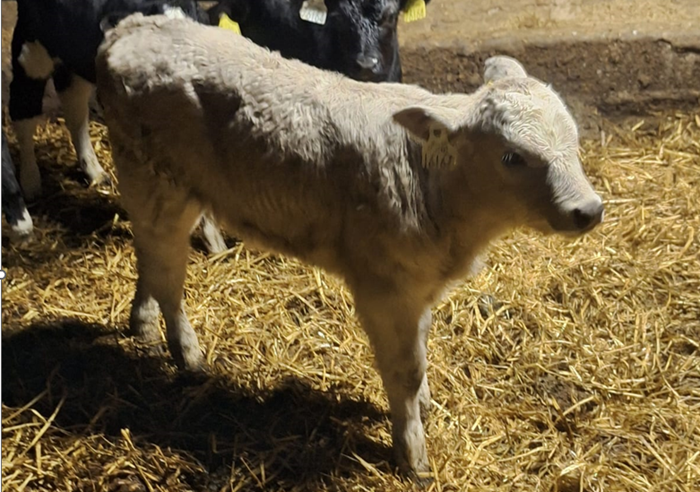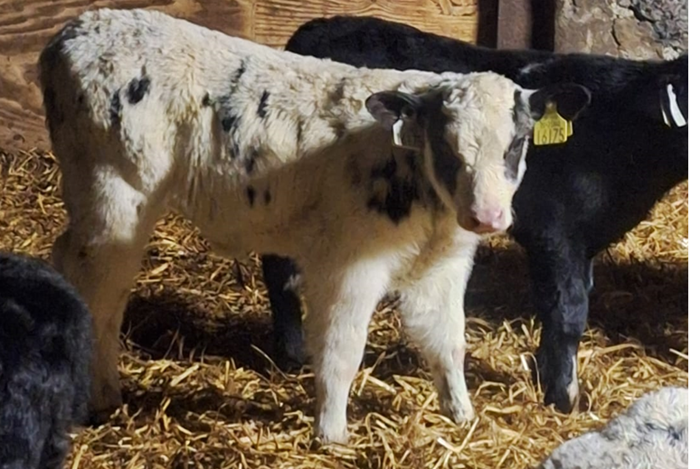14 April 2025
Producing a good, saleable calf without any extra work

DairyBeef 500 Advisor, Fergal Maguire revisits Declan and Matthew Mullen in Co. Meath to see how the beef sires they selected last year have delivered on the ground.
This time last year, we sat down with Declan and Matthew Mullen to select beef bulls for the 2024 breeding season. Now, heading into this year’s breeding season, it’s a good time to evaluate how using high-quality beef bulls impacted their calving season.
To recap, the Mullen family farms 158ha of good, free-draining land outside Kells in Co. Meath. In 2024, they milked an average of 340 cows on a 70ha milking platform. They are currently a monitor farm with the Teagasc/Tirlán Future Farm Programme and work closely with Programme Coordinator Sandra Hayes and local Dairy Advisor Vincent Tracey. The herd follows a split-calving system, with approximately 120 cows calving in the autumn – a system that’s not uncommon in this part of the country.
Sourcing bulls and calving difficulty
One issue Matthew encountered was sourcing the bulls originally selected. When choosing bulls from the ICBF Active Bull List, only bulls marked as “highly available” were selected. However, when Matthew contacted his local AI agent, some of those bulls had sold out or become unavailable for various reasons. Fortunately, the AI agent recommended bulls with similar high beef traits as alternatives.
The Mullens experienced no major issues with difficult calvings, with only a small number requiring assistance. The bull with the highest recorded calving difficulty was a Belgian Blue at 6.1%, but he was only used on bigger, more mature cows, meaning very few needed assistance.

In fact, cow type seemed to have a greater impact on whether assistance was required, as some bulls with lower calving difficulty figures actually had more assisted births. Calving difficulty for the bulls selected ranged from 2.5% for second calvers to 6.1% for older stronger cows.
Gestation
Increased gestation length wasn’t a major issue on the farm, as longer-gestation bulls were used earlier in the breeding season, while shorter-gestation bulls were introduced as the season progressed.
“I found that that the AI Charolais bull worked very well. His calves were very easy to calve, and you had a real stylish calf on the ground that was very saleable,” Matthew commented. This Charolais bull was 4.5% calving difficulty with a beef sub index of €167.
By being more selective when choosing their beef bulls, the average CBV (Commercial Beef Value) of this year’s calf crop is expected to be €118 (4-star), which is a very high average. CBV values ranged from €76 (3-star) for an Angus calf out of a heifer to €171 (5-star) for a Charolais calf. The beef sub index of the bulls used on cows in 2024 ranged from €98 to €167, this is what drives high CBV in calves.
Matthew believes there is a strong correlation between higher CBV calves and marketability.
“You can see that the calf from the better beef bull has a bit more shape and size than the calves from bulls with lower beef traits. I believe this will translate into better prices for these calves.
“Going forward, I will continue to pay more attention to the beef traits of the bulls when sourcing AI straws. You’re producing a good, saleable calf without any extra work or hassle,” Matthew concluded.
Fergal Maguire is an Advisor on the Teagasc DairyBeef 500 Campaign. The above article was adapted for use on Teagasc Daily from an article first published as part of the DairyBeef 500’s Dairy Beef Index Series on Agriland.
Find out more about the Teagasc DairyBeef 500 Campaign here.
More from Teagasc Daily: Breeding choices deliver more beef in Co. Tipperary
